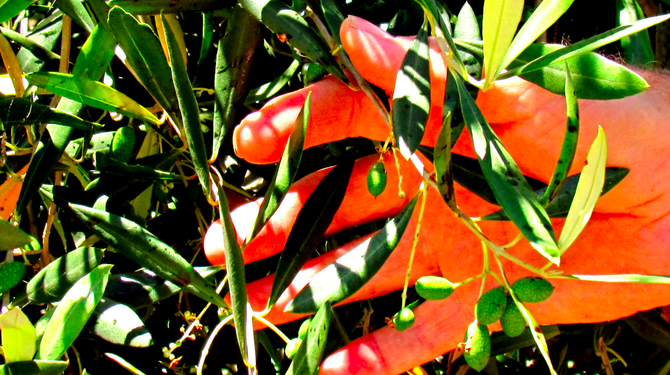 Facebook
Facebook
 X
X
 Instagram
Instagram
 TikTok
TikTok
 Youtube
Youtube

Jim Engelke, owner of Fallbrook Olive Oil, bought an avocado grove in east Fallbrook eight years ago. With the North American Free Trade Agreement allowing the importation of avocados from south of the border and water rates on the rise, Engelke didn’t hesitate to replace the grove with olive trees. The average mature olive tree does well with about 6 to 8 gallons of water a day, he says; the average avocado tree needs 40.
Still, with the olive fruit fly busy infesting yet another year’s crop and the reduced availability of water, growing conditions for olive trees are less than optimal. The California Agricultural Statistics Service reports that 26,944 tons of table olives were produced in 2011; 167,000 tons were reportedly harvested in 2010.
“The olive fruit fly is a severely damaging pest and very well established in San Diego and throughout the state’s important olive-growing regions,“ says Sandy Parks, assistant director of the county’s Agriculture, Weights and Measures office. “University researchers are still trying to find the best way to grow olives using management techniques that are disadvantageous to its development.”
For the majority of the state’s olive growers who produce table olives, a few infested fruit can lead to the rejection of an entire crop. Dr. Gary S. Bender of the county’s UC Davis Cooperative Extension office emphasizes that in order to ensure mitigation methods are successful in keeping the flies at bay, “the whole neighborhood needs to be sprayed at the same time.”
Bender described a project conducted at the Bernardo Winery in Rancho Bernardo that attempted to control the flies after they appeared in the 1990s. “Basically, the trees were sprayed with GF-120 every two weeks and we cut the maggot population down from about four to five per fruit to one to two per fruit. This was still unsuccessful mainly because there were a lot of backyard olive trees in the neighborhood that were not being sprayed, so the flies kept coming into our plots.”
Engelke, meanwhile, feels positive about his 2012 crop.
“While the olive fruit fly is present in our area, we combat it using organic methods and minimize damage to our crop," says Engelke. "Thus far we have not experienced significant damage and have produced an award-winning oil from our olives.”
At the 2011 Los Angeles International Extra Virgin Olive Oil Competition, Engelke’s oil earned a silver medal. His last harvest yielded 1.5 tons and grossed about $10,000. Although this year’s crop looks a bit lighter, Engelke expects a similarly sized crop.


Jim Engelke, owner of Fallbrook Olive Oil, bought an avocado grove in east Fallbrook eight years ago. With the North American Free Trade Agreement allowing the importation of avocados from south of the border and water rates on the rise, Engelke didn’t hesitate to replace the grove with olive trees. The average mature olive tree does well with about 6 to 8 gallons of water a day, he says; the average avocado tree needs 40.
Still, with the olive fruit fly busy infesting yet another year’s crop and the reduced availability of water, growing conditions for olive trees are less than optimal. The California Agricultural Statistics Service reports that 26,944 tons of table olives were produced in 2011; 167,000 tons were reportedly harvested in 2010.
“The olive fruit fly is a severely damaging pest and very well established in San Diego and throughout the state’s important olive-growing regions,“ says Sandy Parks, assistant director of the county’s Agriculture, Weights and Measures office. “University researchers are still trying to find the best way to grow olives using management techniques that are disadvantageous to its development.”
For the majority of the state’s olive growers who produce table olives, a few infested fruit can lead to the rejection of an entire crop. Dr. Gary S. Bender of the county’s UC Davis Cooperative Extension office emphasizes that in order to ensure mitigation methods are successful in keeping the flies at bay, “the whole neighborhood needs to be sprayed at the same time.”
Bender described a project conducted at the Bernardo Winery in Rancho Bernardo that attempted to control the flies after they appeared in the 1990s. “Basically, the trees were sprayed with GF-120 every two weeks and we cut the maggot population down from about four to five per fruit to one to two per fruit. This was still unsuccessful mainly because there were a lot of backyard olive trees in the neighborhood that were not being sprayed, so the flies kept coming into our plots.”
Engelke, meanwhile, feels positive about his 2012 crop.
“While the olive fruit fly is present in our area, we combat it using organic methods and minimize damage to our crop," says Engelke. "Thus far we have not experienced significant damage and have produced an award-winning oil from our olives.”
At the 2011 Los Angeles International Extra Virgin Olive Oil Competition, Engelke’s oil earned a silver medal. His last harvest yielded 1.5 tons and grossed about $10,000. Although this year’s crop looks a bit lighter, Engelke expects a similarly sized crop.
Comments